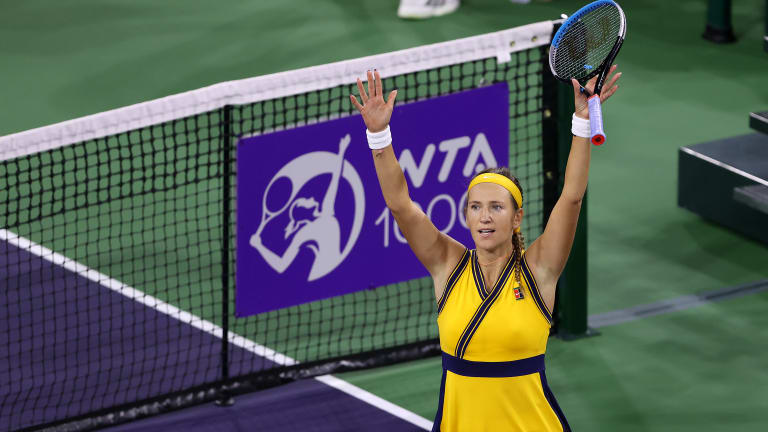There emerged a chain of strength—energy plus footwork fueled improved depth. Now it was Azarenka’s turn to assert herself, as she pinned Ostapenko and began to elicit more errors, most notably off the forehand. From 0-2 down in the second, Azarenka won nine of the next eleven games to go up 3-1 in the third.
Said Ostapenko, “If I was playing maybe a bit smarter, I could win this match in two sets. But then I started to play against myself a little bit. Of course, she was making as many balls as possible, like she was putting more balls in the court, not missing, trying to wait for my mistakes.” This binary view—offense versus defense—reveals a sad gap in Ostapenko’s view of the match, neglecting the nuanced way Azarenka redirected the flow of the match and began to dictate the tempo of a great many rallies.
But then, momentum switched again, Ostapenko breaking Azarenka to even the third at 3-all. From there, any resemblance between tennis and boxing is indeed relevant. Both were hitting big, but with Ostapenko having regained her form, it appeared she might have enough power to overtake Azarenka. Serving at 3-4, 15-all, Azarenka double-faulted, an error triggered by both nerves and Ostapenko’s pace. But on the next two points, Ostapenko misfired a makeable forehand and backhand. Azarenka soon held for 4-all. A similar pattern occurred when Ostapenko served at 5-all, 30-love and then made four straight unforced errors.
Even then, though, serving for the match at 6-5, Azarenka trailed 15-40. One break point was fought off with deep drives from the baseline. The second was saved with a superb 110 mph serve to Ostapenko’s backhand. But then, facing a third break point, came a moment that fully revealed Azarenka’s acumen for problem-solving. Mid-rally, she feathered a backhand down-the-line drop shot and followed it into the net. In charged Ostapenko—and there was Azarenka, reading the crosscourt passing shot perfectly to punch a forehand volley into the open court for a winner. “Can you be more brave than that?” asked a smiling Azarenka. Two points later, Ostapenko lined a forehand into the net.
Azarenka has now reached her first final of 2021, a frustrating year that’s seen her ranking drop from 13 in January to its current spot of 32. “I think my season has been tricky,” she said. “There were parts where I physically couldn't necessarily bring that extra level, extra fight, which was very frustrating. Then there were parts where I felt that I was looking for something to add, and I didn't necessarily know what it was. It was a lot of searching in the season, a lot of kind of stepping into unknown. I feel like right now I'm a bit more settled with a bit more structure, a little bit more discipline, which makes it not necessarily easier but a bit clearer what I need to do.”
It’s rare for a player to reach three finals at the same tournament nearly a decade apart. The first time Azarenka got that far at Indian Wells came during her glory years, barely a month after she’d first become number one in the world. The second happened during a sizzling spring, Azarenka that year winning Indian Wells and Miami—and soon after announcing her pregnancy. The mother angle surfaced repeatedly when Azarenka reached the final of the 2020 US Open and hardly did justice to what she was during that run and has always been, through injuries and many ups and downs. Call Victoria Azarenka simply a competitor, aided tonight by impressive problem-solving skills.
